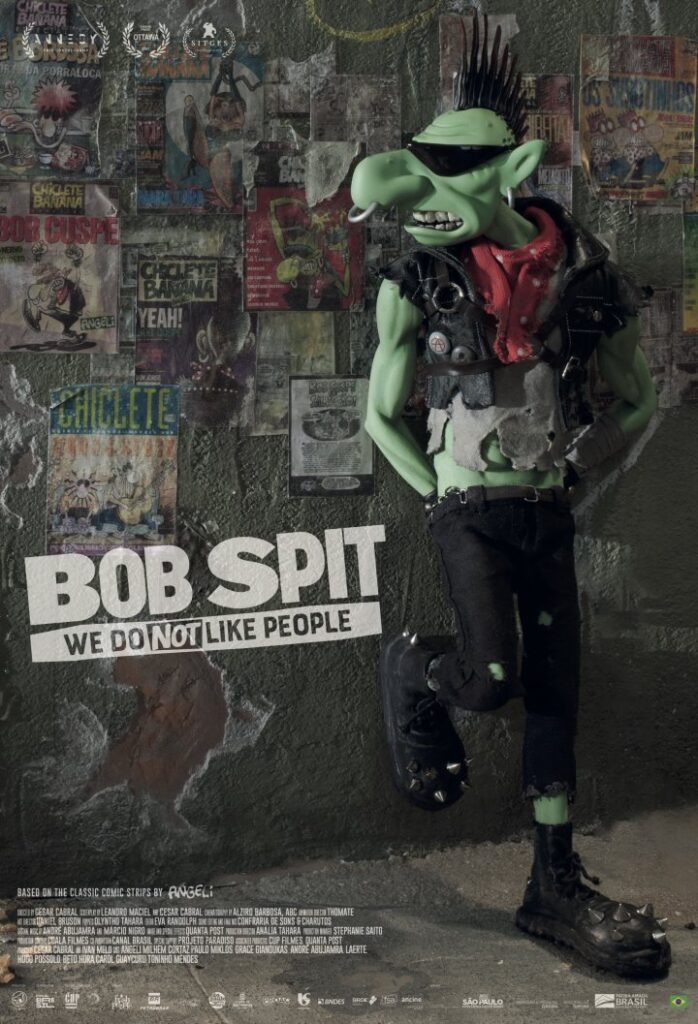
Angeli is an apparently extremely famous cartoonist in Brazil. He has created several iconic characters that are, and combined shock humor with social commentary. He also was, in his youth, dedicated to a punk mentality. I think. Bob Spit: We Do Not Like People has a bit of an overview of the man’s career, and an extended (though idiosyncratic) interview about his philosophy of art. But though it’s a documentary of sorts, it isn’t some kind of introductory treatise.
You can get a feel for Angeli’s work and energy (kind of like a Robert Crumb born a couple decades later with slightly updated references) and for his distaste for explaining himself. Or being seen working. Or talking on camera.
In fact, he doesn’t really talk on camera, because Bob Spit: We Do Not Like People is fully stop-motion animated. It seems to be based on interviews that Angeli barely sat for, and tape recordings he made himself. But that might be contrivance, part of the story made for this depiction of a cartoonist who doesn’t like to talk about his characters. His characters, though, want to talk to him.
The storytelling of Bob Spit is split between the realistic animated interviews with the cartoonist himself, where he largely sits at a desk smoking and does not much want to be interviewed, and the wanderings in a post-apocalyptic wasteland of a couple of old-young punks, the Kowalskis. They’re brothers, and don’t seem to have first names (they just call each other Kowalski.) But they’re ecstatic when one of Angeli’s most famous creations, the green skinned punk Bob Spit, who saves them from a crowd of pop-loving mutants who eat punks for breakfast. Bob Spit (Bob Cuspe in the original Brazilian Portuguese) is pure punk malevolence. He runs taciturn and aggressive, and carries a shot gun in case he has to defend himself from mutants.
And he does, because Angeli is, apparently, famous for killing off his characters at the height of their popularity. And Bob’s fate is to be eaten by mutants, who all have slicked back hair and sparkly clothes and star shaped sunglasses. Angeli calls them “little Elton Johns” and they represent the pop music. Pop kills punk.
But in a graphically violent fight scene, Bob isn’t killed. He fights back, after the mutants invade his house and attack him when he’s on the toilet. He gets up, full Monty swinging as he’s swinging his punches at the multiheaded Elton John monstrosity. Bob was supposed to die, and when he doesn’t it upsets the Kowalski’s – that didn’t fulfill the prophecy. That is to say, Angeli’s comic books. Bob Spit wants to show Angeli where he can shove his “prophecies”, and so goes on a road trip to find his creator and spit in his face.
This is the basic plot structure of this odd, self-consciously post-modern exploration of the relationship between a creator and his creations. The post apocalypse violence scenes are interposed with more staid documentary interviews. The participants are Angeli (a very unwilling participant), Carol, who might be in a relationship with him, and old friend Laerte, who sends him a reminder of one of his most popular characters that he notoriously killed.
I think. Being completely unfamiliar with Angeli’s output means I don’t know how much of this film is documentary truth and how much of it is invented for the story. I’m discounting the reality of the green skinned mutant killing post-apocalyptic punk enthusiast. Everything else, though, has the ring of a documentary, since it isn’t very satisfactory.
Angeli claims he doesn’t have much interest in the past, and is willing to throw away pretty much all of his memorabilia, but he papers a wall with it. And he participates in a film about his old characters coming back to get a piece of his mind.
While the film is an original, it seems (from my minimal internet research) to be a continuation of a stop-motion television series based on Angeli’s works. I’ve never seen any of it, but the models are pretty highly detailed. They look more like low-budget Laika (the studio who made Coraline) than old Rankin Bass cheap felt. Several of the characters are relatively realistic human models, and while not too emotive, they have an almost eerie sense of life.
The real question, I suppose, is, “what is the point?” There’s a meta-textual story about the difficulty of separating creation from creator, even as neither wants much to do with the other. That’s interesting, but I don’t doubt it would have a great poignancy if I, or the audience, were more familiar with the subject material. Watching a film about characters I’d known for 30 years come to life couldn’t help but have more resonance than coming in cold on odd balls from another culture with which I have no touchstones.
That said, Bob Spit is frequently funny. The violent animation is fun, for those who like violent animation. There’s a terrific comic sequence involving a border guard who want special favors before they let Bob’s cab go across the border. It’s atmospheric, trippy, and frequently gross. Visually, the film has the hang ups of stop-motion which bother some but I find part of the medium’s charm.
And it tells a poignant story about art, fame, and the line between being lifted up by one’s creations, and being confined. At one point Angeli states essentially he’s in complete control of his characters, and that’s why he’s always ready to let them die and move on. Bob Spit: We Do Not Like People is his own character’s rebuttal, and it takes the artist (if he is indeed the artist – the movie gets very meta) on an entertaining journey to find out whether he knows what he’s talking about or not.
Bob Spit: We Do Not Like People has its Los Angeles theatrical debut today, December 15th, at the Laemmle NoHo 7.